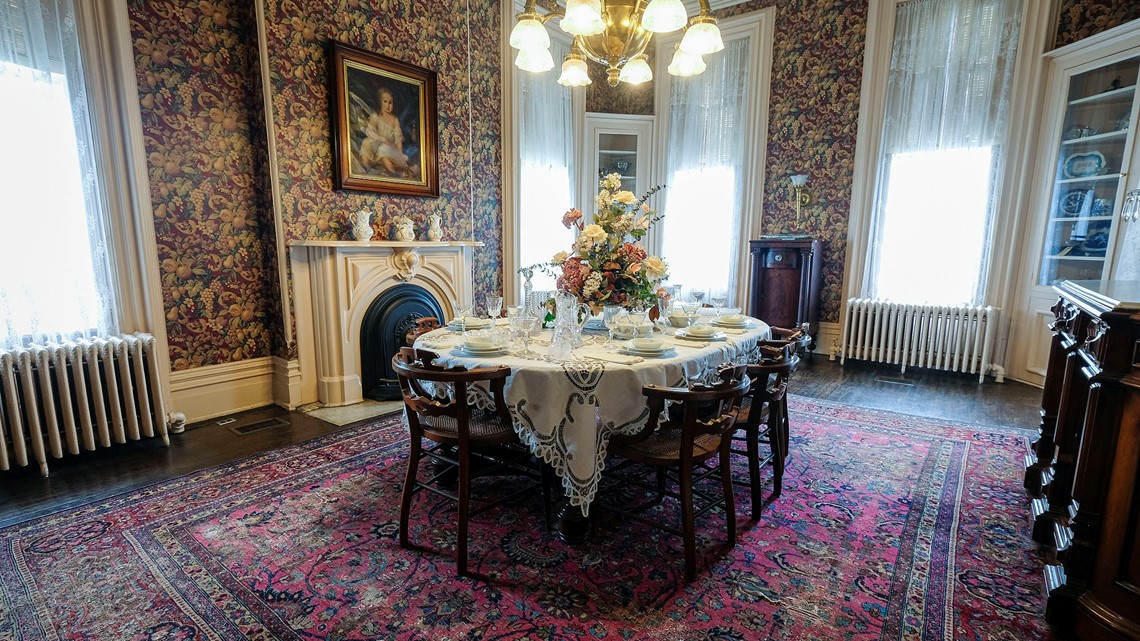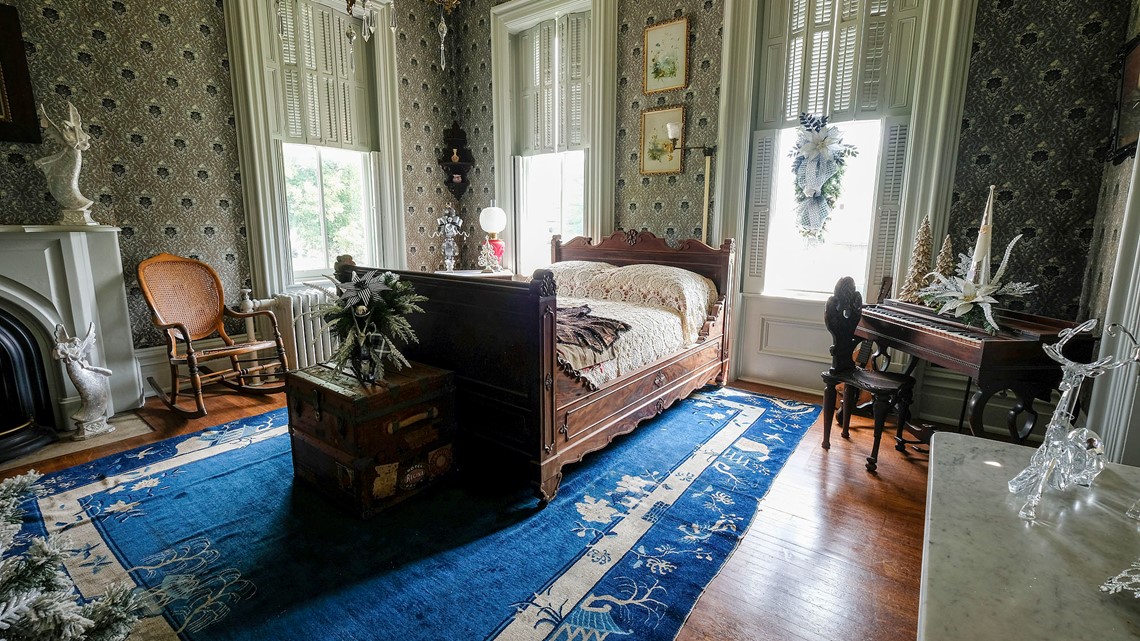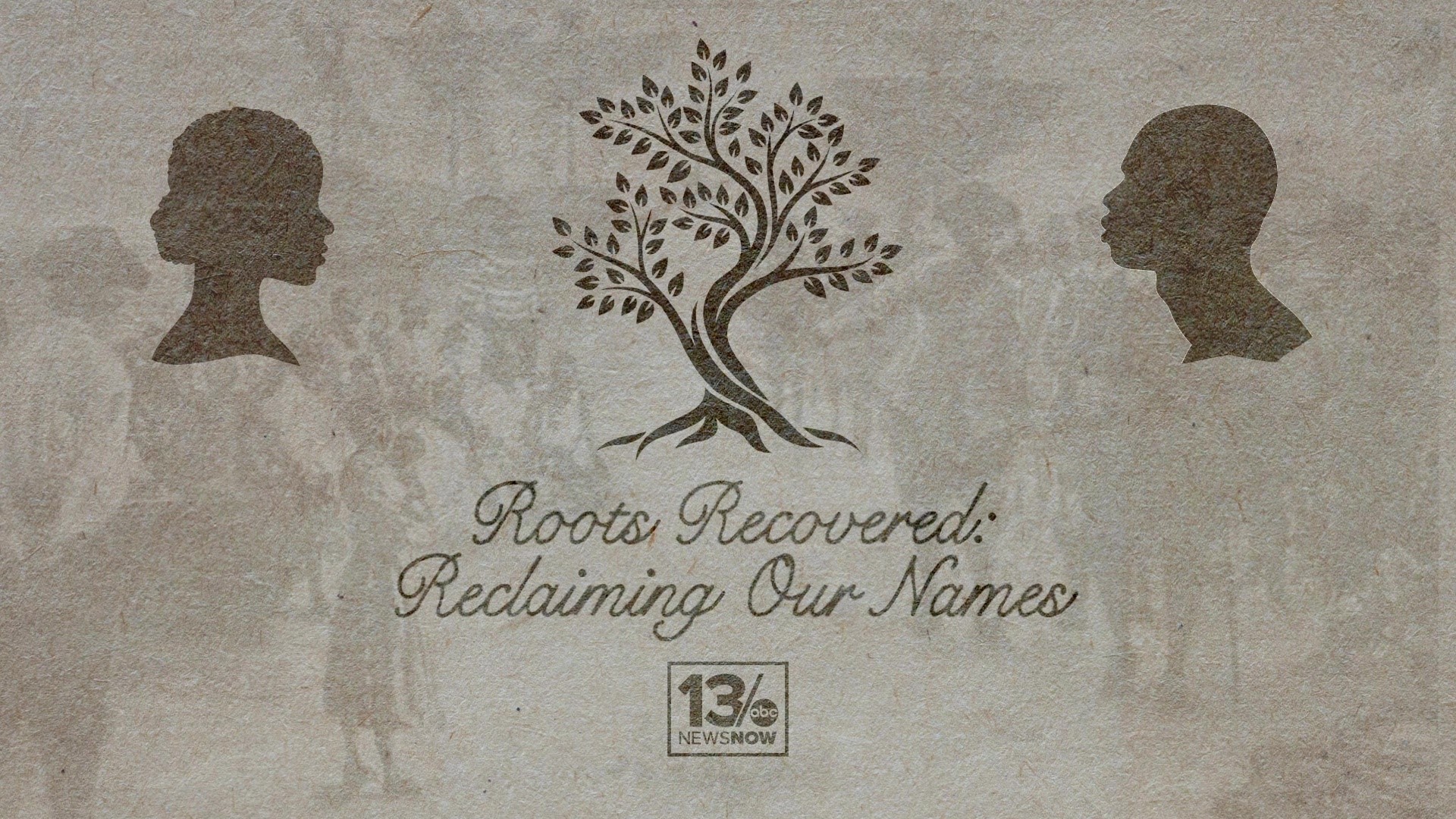CAIRO, Ill. — Charles A. Galigher, and his wife, Adelia Lippit Galigher, moved to Cairo in the 1850s from Zanesville, Ohio, on the prospect of a risky business venture.
Together with Mrs. Galigher’s brother, they purchased shares of a bankrupt flour mill. Within a year, they had turned the company profitable; the brother sold his shares and returned to Ohio. Under two labels — Superior White and Premium Eagle — the company sold flour around the world, including in the United Kingdom, to Queen Victoria, and on the homestead, to the U.S. government during the Civil War.
By time the war ended, the Galighers were wealthy.
With their fortune, they decided to build a mansion in Cairo.
In 1869, they laid the foundation for what is known today as Magnolia Manor. Eventually, it would expand to 8,000 square feet, with five flights of stairs leading to a cupola that overlooks the city; at the top, they’d install a window that opens onto a widow’s walk where the Galighers and their company could escape the swampy summer mosquitoes and gaze out across the confluence of the Mississippi and Ohio rivers.
But first, they let the foundation settle for an entire year, an old carpenter’s trick to ensure a sturdy and lasting home.
And it has been — for about 150 years.


But today, the Cairo Historical Association, which has owned the home since 1952, is running short of cash to continue its operations as a museum. Those dedicated to its upkeep worry what will become of the mansion if they’re forced to shut off the utilities. Charles McGinness, the association’s president, said the problem is pretty simple: “We’re flat broke.”
Utilities and monthly payments to the home’s caretaker and tour guide, who lives downstairs, far exceed incoming donations and proceeds from tours. The pandemic has been especially bruising to the association’s finances, causing reduced tours and the anticipated cancellation of the annual Holiday House luncheons event, its largest annual fundraiser, McGinness said. Then there are the bigger, more costly repairs that are past due.
The home needs a new roof and tuck pointing work. Bricks are falling behind the house onto the porch. There are two leaks, one in the library and one in the roof, which threaten structural damage. “We’re needing some major work done. We’re really just treading water,” McGinness said. “I always tell people, when they say, ‘How’s it going?’ I say, ‘Well, you know that scene of the Titanic at the end where the ship’s standing up at a right angle and they’re holding onto the top? That’s where we are. We’re holding onto the top.’”
When Charles Dickens passed by Cairo in 1842 as he traveled from Cincinnati to St. Louis on an American expedition, he had only unkind words for the place. Though “vaunted in England as a mine of Golden Hope” for its prized location at the foot of two major economic arteries, Dickens said he found Cairo to be a “dismal swamp”; ... a “breeding-place of fever, ague, and death”; … an “ugly sepulchre, a grave uncheered by any gleam of promise.”
It was about a decade later when the Galighers arrived here.


Charles was an ambitious man. He graduated from University of Ohio at age 15. So perhaps it is not surprising that he saw in Cairo a diamond in the rough. Though, he was not the only one. In 1850, Cairo was home to only a few hundred people. By 1860, the town had grown to a little more than 2,000 people. But it was the Civil War that would dramatically change the town’s trajectory. Cairo’s location at the confluence, and on the dividing line between the North and South, rendered it critical to the war effort.
During the war, Cairo hosted some 12,000 Union soldiers under the direction of Ulysses S. Grant.
“Although the disruption of river traffic originally undermined the economic position of Cairo … the war soon brought the city its finest hour,” the late John M. Lansden, a long time Cairo resident, wrote in his 1910 book, “A History of the City of Cairo, Illinois.”
War, Lansden noted, necessitated money, “and Cairo having become a great military station and depot, money soon began to make its appearance in a way never dreamed of by any one in the town…” As a result, many people “became comparatively wealthy who had never expected to attain unto more than a comfortable competency.”
Galigher’s flour milling business was certainly among those buoyed by the war effort. He made a tidy sum selling the government hard, dry bread and biscuits — known as hardtack — for Union soldier rations. Through his business dealings, Galigher struck up a friendship with Grant that lasted beyond his presidency.
After the war ended, Cairo’s economy grew at a steady pace. Hundreds of small-scale industries and retail stores sprang up. They included barrel factories, breweries, grain and timber mills, brickyards, tool and box manufacturers, sausage producers, cigar makers, banks, hotels and restaurants, according to a 1997 article in the Illinois Historical Journal.


That article by historian Christopher Hays specifically discussed the African American struggle for equality and justice in post-Civil War Cairo. Cairo’s growing population during this era is partly attributed to the fact that the government brought thousands of runaway slaves to Cairo during the war.
The “contraband” camp, as it was known, was disbanded after the war ended, and many Black people returned to the South. But about 3,000 stayed, forging their own distinct society in Cairo. Recently freed Black people during this era achieved considerable advancements, but also faced staunch oppression from the white power structure; as such, their world stood in stark contrast to the one in which elite white businessmen like Galigher circulated.
It was during this era of the post-war boom that the Galighers laid the foundation for Magnolia Manor on what was then upper Washington Avenue. They wrapped up construction on their red brick Victorian mansion three years later, in 1872. That’s when Charles and Adelia and their three sons, Frank, Albert and Charles, moved in. The home sat on two acres, in a part of town then considered “suburban” Cairo, away from the hustle-and-bustle of the downtown merchant district.
The mansion consists of four stories and 14 rooms. It has double brick walls with a 10-inch airspace between them to allow for ventilation. It was heated in the winter by coal-burning fireplaces located throughout; the two in the drawing room are made of Carrara marble. The Galighers also enjoyed a form of air conditioning. Raising the lid of the dome, seen from the second and third floors, in conjunction with the skylight on the roof, would pull hot air out of the house. A further sign of luxury and wealth, they had two bathrooms with running water pumped from an artesian well.
The Galighers spent about $40,000 to build the house. It contained roughly 40,000 bricks, purchased for about $1 each, according to a short historical account of the home by the Cairo Historical Association.
The bricks were made locally at the Klein brickyard. The home, designed by Galigher and his wife, was modeled after the Italianate form of architecture, known for its wide eaves, ornate brackets, large porches and often, cupolas.


It was the third home built in the area of what would eventually become known as Millionaire’s Row. On four corners stood Magnolias, built first in 1856; Riverlore, built in 1865; and Magnolia Manor and the Greenways, both built in the 1870s.
The home and all its assets stretched over an entire city block. Also included on the property were gardens, tennis courts, a carriage house, cisterns, wells, a small building used to manufacture carbide gas to light the house, and a miniature steam powered locomotive for the children to ride.
The Galighers had a staff of six servants: maids, a cook, a governess and a man who took care of the yard and stable. Consistent with the era, the workers were likely Black people, but little is told of their experience in the home, or about their lives. There is no representation of them in the museum. McGinness said that’s because he knows of no records in the association’s possession that would have told their story.
The Galighers spent almost as much time and money on the inside of the home as they did on building it. After moving in, they put off decorating it for two years because Adelia had fallen sick, said Tim Slapinski, the home’s curator and tour guide. Once she was on the mend, Adelia hired an interior decorator from St. Louis to live in the home for two years and design its 14 rooms.
“It cost him $35,000 to furnish the house — almost as much as it cost him to build it,” Slapinski said.
Some of the original furnishings remain, such as the table and chairs in the dining hall, chapel chairs in the reception room, several of the chandeliers, and the bronzed French cavalier perched atop the circular cherry staircase, standing guard and guiding the way from the carbide fueled light held above his head.
Also original to the home is all the walnut furniture in the master bedroom on the third floor, and the Renaissance bed in which then former President Grant slept in a guest room down the hall when he visited Cairo in 1880.
Grant and his wife, Julia, stopped in Cairo on their way home to Galena at the conclusion of a two-and-a-half-year world tour they embarked upon following the end of his presidency. Local officials hosted a large reception for Grant at the Halliday Hotel; it was estimated he shook hands with 5,000 people at that event. Legend has it that back at the Galighers that night, he burned a hole in in his bed linens while smoking a cigar in bed. Mrs. Galigher, so the story is told, was none too pleased.
In addition to famously hosting the Grants, the Galighers were known for their lavish parties, social affairs and church gatherings. Of a party they once held in the home, the Daily Cairo Bulletin wrote in its Dec. 22, 1878, Sunday morning edition: “It is needless to add, since Mr. And Mrs. Galigher are known as the host and hostess of the occasion, that the visitors were most handsomely and courteously entertained.”


Today, the home is also brimming with many other treasured “Cairo” pieces that were not original to the Galighers, but donated over the years. That includes a bright round blue couch in the drawing room upon which Teddy Roosevelt sat while visiting the home of then-Mayor George Parsons in 1907.
Other noteworthy historical pieces include the secretary in the third floor hallway that belonged to Shadrach Bond, Illinois’ first governor, and a pre-Revolutionary War grandfather’s clock in the library.
In its 150-year existence, the home has only had four owners, including the Cairo Historical Association, which has owned it for nearly the past 70 years. McGinness, who has spent his entire life in Cairo, recalled volunteering as a tour guide at the home as a teenager.
Back then, the home turned museum was busier. Cairo was still a popular stop for the Delta Queen and Mississippi Queen riverboat tours, he said. When the ships ported in Cairo for the day, passengers would get picked up and driven around to various points of interest in Cairo, including Magnolia Manor.
McGinness said he knows that people in town appreciate the home and its historical significance. It was added to the National Historic Register in 1969, because of its significance in hosting the Grants, as well as that it stands as an “outstanding example of Italianate architecture and typifies a fine southern Illinois home of the period.”


But it’s gotten harder over the years to raise money and get people to volunteer, he said. For one thing, people seem to have busier schedules and other interests, he said. As well, Cairo has lost much of its population and economy.
Cairo had grown from the few thousand who lived there around when the Galighers arrived to about 15,000 by the time Galigher died in 1915. But today, the population is roughly the same as it was in 1860, prior to the Civil War. Some of the homes on Millionaire’s Row have since come down. But a few still stand, including this one and Riverlore, constructed in 1865 for William Parker Halliday, a prominent businessman and riverboat captain. Another stately home located across the street from Magnolia Manor, constructed by William Halliday’s brother, Thomas, in 1876, also still stands.
The homes did not always go by these names. Magnolia Manor was chosen from a naming contest with Cairo school children once it was purchased by the Cairo Historical Association. At the time, the home was surrounded by Magnolia trees.
The city purchased Riverlore in 1999 for $250,000 but also struggled to maintain it over the years, eventually prompting officials to place it for sale. A couple from Union County purchased the home about a year ago and is in the process of restoring it into a bed-and-breakfast and venue for private functions.
McGinness said he doesn’t have answers for Magnolia Manor, but he’s hoping someone else might. “There’s nowhere that I know of right now to get any money. I’ve got people looking but nobody has found anything yet,” he said.
“I’m hoping there’s somebody out there who can give us a bunch of money,” he said, “or give us some direction.”





